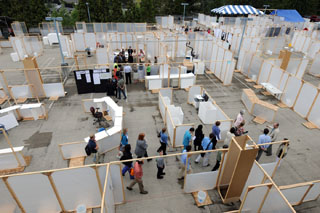|
Subscribe / Renew |
|
|
Contact Us |
|
| ► Subscribe to our Free Weekly Newsletter | |
| home | Welcome, sign in or click here to subscribe. | login |
Construction
| |
 |
April 17, 2013
Hospital design started with yarn, cardboard and duct tape
Seattle Children’s Hospital

Johnson
|
Seattle Children’s Hospital’s main campus is expanding to accommodate our growing need for additional beds.
The new facility, aptly named Building Hope, opens on April 21 and will include a new emergency department, critical care unit, and cancer care unit with a wing designed specifically for the teens and young adults.
For more than a decade we have used a philosophy called continuous performance improvement, or CPI, to evaluate and refine processes within the hospital to provide the best service to our patients and families.
Our ultimate focus is the safety and satisfaction of our patients and families. We actively seek feedback from staff, patients and their families on their hospital experiences. Their input helps us streamline processes, minimize wait time and cost, and deliver high-quality care.
We designed Building Hope by applying our CPI philosophy and principles to space design, through a process known as integrated facility design (IFD). We believe IFD is the best way to create spaces that will provide the best patient and family experience.
A look from every angle
IFD is based on lean design principles. Lean design can be used to improve the production of anything from the assembly of a car, to the internal processes of a business, or even the design of a building. The ultimate purpose and concept of IFD and lean design is to achieve customer satisfaction by using efficiencies and limiting the waste of space, equipment, material, effort, time and capital.
For Building Hope, IFD allowed us to look at the new building from every angle to ensure that it will meet the needs of the people who work there and the patients they care for. The process allowed us to learn about the day-to-day issues our providers and patient families face, and to see how we could best address them before we broke ground.
As our design work began in earnest, we used IFD and lean principles to look at how to best lay out key spaces and features within the new building. The design team, including ZGF Architects, Sellen Construction and Joan Wellman and Associates, engaged the critical care, emergency and cancer teams early on to help identify areas of waste and improvement.
Delivering superior patient care means a focus on patient safety, comfort, satisfaction and experience, all of which were primary factors in creating a successful new space. For instance, we used data from our existing emergency department to reconfigure admitting procedures, staff circulation, room layout, inventory and discharge procedures. By using yarn to demonstrate distance and routes that patients and staff take on a daily basis, the teams were able to find areas that could be streamlined.
Life-size model
Following the initial design process, we built a life-size floor model of Building Hope out of cardboard and duct tape in a south Seattle warehouse. The model allowed us to test the building flow for patient and staff experience, validate our design assumptions, identify potential problems and propose solutions.
We then invited physicians, patients, nurses and parents to walk through and experience the new design. Their feedback helped us as we refined our plans to solve issues and improve the design before actual construction began.
With the floor model in place, we simulated numerous exercises to replicate patient and staff experiences from arrival and check-in, to care in the patient rooms and finally discharge. In the end, the IFD process allowed us to vastly improve upon the typical family experience at a traditional hospital.
A patient perspective
We brought together a unique advisory board made up of patients, families and hospital staff to provide critical input and feedback throughout the design process. Their perspective helped shape the spaces and processes that we see today in Building Hope.
By listening to former patients and their families, we were able to understand the real needs of the children and families we serve. Their input was invaluable in designing a building that would make their hospital experience as comfortable and healing as possible.
Cassandra Sage, the mother of a former patient, was one of the many parents who participated in our advisory board. She told me, “To me, the most impressive part of the design process was how earnestly Seattle Children’s Hospital staff wanted patient and family input — how much everyone on the team desired to make the stressful experience of being in a pediatric hospital the best it can be by including us and partnering with us.”
The key at every stage of this project has been to bring together the right people with the right knowledge to design and plan not only the physical building, but also the systems and processes that will make it work. There are many of those people, both outside and inside Children’s.
More than 17,000 staff hours went into the planning and design of Building Hope. Applying our CPI principles to facility design was the next step on our lean journey and allowed us to build the best space possible for patients, families and staff. As we get ready to move patients into the new space this weekend, we’re excited to see that vision come to life.
Todd Johnson has overseen facilities at Seattle Children’s Hospital for five years and manages the current Building Hope expansion project.
Other Stories:
- Ultra-efficient mechanical systems offer lots of ways to cut costs
- How to create spaces that help children heal
- A unique to-do list: move 68-ton tree and play Where’s Waldo with kids



